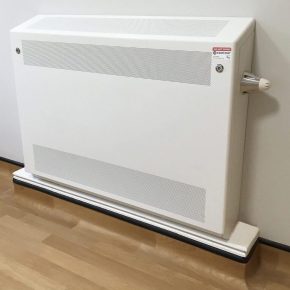
Young Offender Institutions: The Design Considerations with Contour
This piece from Contour explores the design considerations for young offender institutions, in order to allow for the best possible chance of rehabilitation and for officers to manage behaviours effectively.
Young offender institutions (YOIs) have high levels of suicides, bullying and unsafe conditions for offenders. In fact, YOIs and youth establishments have the highest assault rates of any prisons in England and Wales, according to politics.co.uk.
This prompts architects and designers to consider the custodial and detention equipment they specify.
Anti-Ligature Solutions
Radiators and guards within young offender institutions should be designed to be extremely difficult to use the radiator or guard as a ligature risk.
This is particularly important as young offender institutions are susceptible to suicide and bullying to other individuals. So, bullies could use sharp radiator parts to harm others.
Radiators, and any ligature points below head-height, are an often-overlooked ligature risk in many high-security environments.
Architects and designers need to be aware of the methods that suicidal individuals use to carry out the critical act of hanging.
The Oxford Academic found that approximately 50% of hanging suicides are not fully suspended, meaning that ligature points below head level are commonly used.
With this in mind, anti-ligature solutions need to be considered. Contour recommend there to be no gaps or joints and for grilles that are IP3X to avoid anything being tied between them.
Bull-nosed, rounded corners and having no sharp edges need to be considered to avoid harm to individuals and other service users.
Built To Withstand Acts Of Vandalism
Vandalism is also prevalent within young offender institutions – it can lead to inmates using furniture to break ‘weak points’ in cell walls.
Therefore, it is important to look for a radiator guard that is strong and robust to withstand such damage.
Zintec steel material is a strong solution to protect radiators from vandalism, damage, and corrosion.
Heating Efficiency
Some traditional radiators operate on a pipe coil system, which has several drawbacks from a design and efficiency perspective.
Often obtrusive and unattractive, pipe coil systems use far more water due to its wide diameter pipe, in comparison to an anti-ligature radiator-which operates on a much smaller section of pipework, whilst taking up less cell space.
Anti-ligature radiators can work to reduce the need for radiators to run for prolonged periods and therefore can heat up quicker.
Cell Hygiene
Officers are responsible for the wellbeing of youth offenders and the hygiene of cells. These cells are frequently subjected to traumatic and unsanitary conditions involving, blood, vomit, and other bodily fluids. This poses a severe health risk for prisoners and staff.
Therefore, radiators must have easy access for cleaning and maintenance, to ensure cell hygiene is optimised.
Reducing Stash Points
With high suicide rates and bullying in YOI’s, articles have found that radiators can be used as stash points for weapons or blades. Stash points also can be used to smuggle illegal goods.
To prevent the use of stash points, officials need to consider the design features of the furniture used in cell spaces.
Therefore, you should look for a radiator solution with small grilles – Contour recommends IP3X to ensure nothing can be wedged into the radiators.
Conclusion
Contour’s anti-ligature radiators are designed with IP3X grilles, to ensure there are no ligature risks.
With bull-nosed corners, rounded edges, no sharp points, and being made with Zintec steel, the radiators are strong and robust to avoid harm to service users.
Hygiene is carried out with easy access for cleaning and maintenance as covers can drop-down effortlessly. To drive hygiene further, BioCote® anti-microbial protection is introduced at the manufacturing stage.
This unique, patented additive provides an effective, safe and long-lasting solution to combatting a wide range of dangerous bacteria, including MRSA and E.coli.
Contour can be contacted at;
The Mansions
43 Broadway
Shifnal
TF11 8BB
Tel: 01952 290 498
Email: sales@contourheating.co.uk
Visit Supplier's page
Latest news

28th March 2025
Ideal Heating Commercial announces 10-year warranty on Evomax 2 boiler
Evomax 2, the UK’s number one selling commercial wall-mounted boiler from Ideal Heating Commercial, is now available with a 10-year warranty.
Posted in Articles, Building Industry News, Building Products & Structures, Building Regulations & Accreditations, Building Services, Facility Management & Building Services, Heating Systems, Controls and Management, Heating, Ventilation and Air Conditioning - HVAC, Innovations & New Products, Pipes, Pipes & Fittings, Plumbing, Retrofit & Renovation, Sustainability & Energy Efficiency, Videos
28th March 2025
FLIR Si1-LD Acoustic Imaging Camera for Compressed Air Leak Detection
FLIR, a Teledyne Technologies company, introduces the Si1-LD, an industrial acoustic imaging camera that brings faster and more accurate compressed air leak detection to those operating on a modest condition monitoring budget.
Posted in Acoustics, Noise & Vibration Control, Articles, Building Industry News, Building Products & Structures, Building Services, Facility Management & Building Services, Information Technology, Innovations & New Products, Retrofit & Renovation, Sustainability & Energy Efficiency, Thermal Imaging and Monitors
28th March 2025
LIFTEX 2025 Seminar programme announced
Registration has opened for LIFTEX 2025. Now in its 37th year, LIFTEX 2025 is the UK’s only dedicated exhibition for the lift, escalator and access industry and takes place only once every three years.
Posted in Access Control & Door Entry Systems, Accessibility, Articles, Building Industry Events, Building Industry News, Building Products & Structures, Building Regulations & Accreditations, Building Services, Exhibitions and Conferences, Facility Management & Building Services, Health & Safety, Retrofit & Renovation, Security and Fire Protection, Seminars
28th March 2025
MCRMA welcomes ArcelorMittal UK to membership
A UK division of the global steelmaking business ArcelorMittal has become the latest new member of the MCRMA, the industry association representing the metal building envelope sector.
Posted in Articles, Building Associations & Institutes, Building Industry News, Building Products & Structures, Building Systems, Cladding, Facades, Posts, Restoration & Refurbishment, Retrofit & Renovation, Roofs, Steel and Structural Frames, Walls
 Sign up:
Sign up: